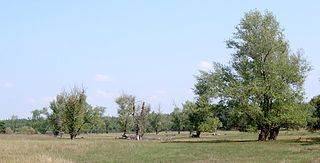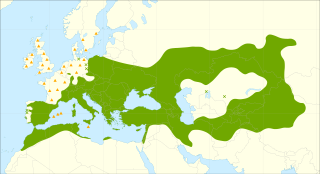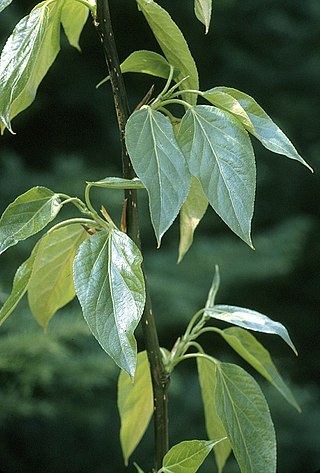In Greco-Roman mythology, Leuce, also spelled Leuke, was a nymph and a daughter of the Titan Oceanus.

Populus is a genus of 25–30 species of deciduous flowering plants in the family Salicaceae, native to most of the Northern Hemisphere. English names variously applied to different species include poplar, aspen, and cottonwood.

Poplar Hills is a home rule-class city in Jefferson County, Kentucky, United States. It is a part of the Louisville Metro government, but operates as a city under the Mayor to Commissioner form of government. Per the 2020 census, the population was 380, but the city administration has made several annexation ordinances that have passed and awaits updated information. The current city population is estimated to be 2380. It currently has the highest population density for any city in Kentucky.

Populus section Aigeiros is a section of three species in the genus Populus, the poplars. Like some other species in the genus Populus, they are commonly known as cottonwoods. The species are native to North America, Europe, and western Asia. In the past, as many as six species were recognized, but recent trends have been to accept just three species, treating the others as subspecies of P. deltoides.

Liriodendron tulipifera—known as the tulip tree, American tulip tree, tulipwood, tuliptree, tulip poplar, whitewood, fiddletree, lynn-tree, hickory-poplar, and yellow-poplar—is the North American representative of the two-species genus Liriodendron, and the tallest eastern hardwood. It is native to eastern North America from Southern Ontario and possibly southern Quebec to Illinois eastward to southwestern Massachusetts and Rhode Island, and south to central Florida and Louisiana. It can grow to more than 50 m (160 ft) in virgin cove forests of the Appalachian Mountains, often with no limbs until it reaches 25–30 m (80–100 ft) in height, making it a very valuable timber tree. The tallest individual at the present time (2021) is one called the Fork Ridge Tulip Tree at a secret location in the Great Smoky Mountains of North Carolina. Repeated measurements by laser and tape-drop have shown it to be 191 feet 10 inches (58.47 m) in height. This is the tallest known individual tree in eastern North America.

The Kentucky River Palisades are a series of steep, scenic gorges and limestone outcroppings that stretch for approximately 100 mi (160 km), along the Kentucky River in central Kentucky in the United States.

The Kentucky coffeetree, also known as American coffee berry, Kentucky mahogany, nicker tree, and stump tree, is a tree in the subfamily Caesalpinioideae of the legume family Fabaceae, native to the Midwest, Upper South, Appalachia, and small pockets of New York in the United States and Ontario in Canada. The seed may be roasted and used as a substitute for coffee beans; however, unroasted pods and seeds are toxic. The wood from the tree is used by cabinetmakers and carpenters. It is also planted as a street tree.

Populus nigra, the black poplar, is a species of cottonwood poplar, the type species of section Aigeiros of the genus Populus, native to Europe, southwest and central Asia, and northwest Africa.

Populus alba, commonly called silver poplar, silverleaf poplar, or white poplar, is a species of poplar, most closely related to the aspens. It is native to a region spanning from the Atlas Mountains of Africa, through most of South and Central Europe, into Central Asia; it has been introduced to many temperate, moist regions worldwide. It grows in moist sites, often by watersides, in regions with hot summers and cold to mild winters.

The Arboretum, State Botanical Garden of Kentucky, 40 hectares or 100 acres (0.40 km2), is located at the University of Kentucky in Lexington, Kentucky, United States. It is open to the public from dawn to dusk every day of the year. The Arboretum hosts 18 tree species native to Kentucky, as well as 80 other native Kentucky plant species. In total, the Arboretum contains more than 1,200 native species.

Parachinar is a large Pashtun town which is the capital of Kurram District in the province of Khyber Pakhtunkhwa, Pakistan.

The Nannine Clay Wallis Arboretum 4 acres is a non-profit arboretum located at the Garden Club of Kentucky, Inc.'s State Headquarters, 616 Pleasant Street, Paris, Kentucky. The Arboretum is open to the public, sunrise to sunset, free of charge.

Davie Poplar is a large tulip poplar tree located in McCorkle Place on the campus of the University of North Carolina at Chapel Hill. Named in honor of Revolutionary War general and university founder William Richardson Davie, the tree is approximately 300 to 375 years old.

Jenny Wiley State Resort Park was founded as Dewey Lake State Park on January 1, 1954, with Dewey Lake near Prestonsburg, Kentucky as its centerpiece. It was renamed in the early 1950s for Virginia "Jenny" Wiley, a pioneer woman who is remembered as a survivor of captivity by Native Americans. It became one of the resort parks in the state in 1962 with the opening of the May Lodge.

Populus balsamifera, commonly called balsam poplar, bam, bamtree, eastern balsam-poplar, hackmatack, tacamahac poplar, tacamahaca, is a tree species in the balsam poplar species group in the poplar genus, Populus. The genus name Populus is from the Latin for poplar, and the specific epithet balsamifera from Latin for "balsam-bearing".

Beargrass Creek State Nature Preserve is a 41-acre (17 ha) nature preserve located in Louisville, Kentucky's Poplar Level neighborhood, in roughly the central portion of the city. It is named for Beargrass Creek, the south fork of which passes along the northern side of the preserve. The preserve is adjacent to Louisville's Joe Creason Park and the Louisville Nature Center. It is owned by the Office of Kentucky Nature Preserves and the LNC assists with management.

Populus grandidentata, commonly called large-tooth aspen, big-tooth aspen, American aspen, Canadian poplar, or white poplar, is a deciduous tree native to eastern North America.

A genetically modified tree is a tree whose DNA has been modified using genetic engineering techniques. In most cases the aim is to introduce a novel trait to the plant which does not occur naturally within the species. Examples include resistance to certain pests, diseases, environmental conditions, and herbicide tolerance, or the alteration of lignin levels in order to reduce pulping costs.

Odontopus calceatus is a species of weevil which occurs in much of the eastern and southeastern United States. Its range is as far north as Massachusetts all the way south to the Gulf of Mexico, and from the Atlantic westward to the Mississippi River. Common names include yellow poplar weevil, sassafras mining weevil, tuliptree leafminer, tulip tree weevil, or the magnolia leaf miner.




















